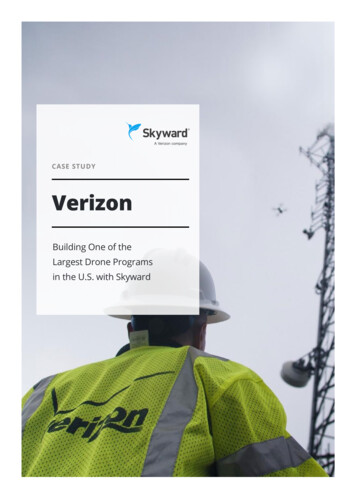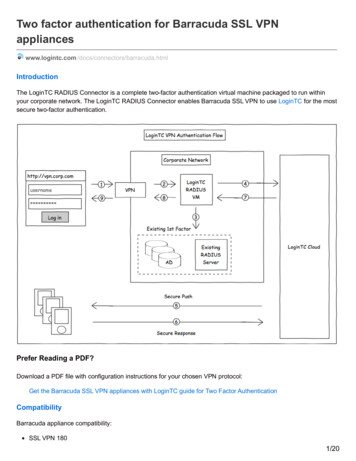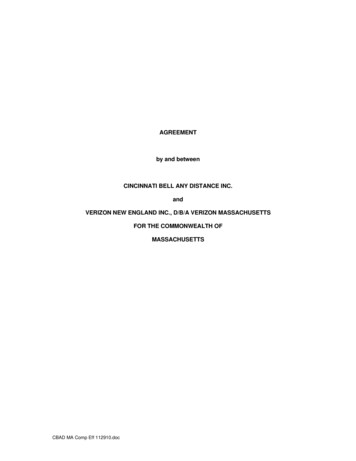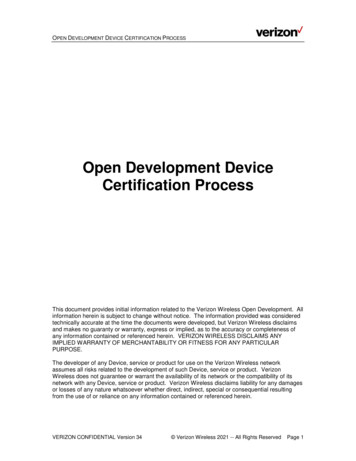
Transcription
CASE STUDYVerizonBuilding One of theLargest Drone Programsin the U.S. with Skyward
CASE STUDY: VERIZONVerizon is always looking for ways to advancetechnological innovation, reduce expenses,and improve worker safety as it maintainsthousands of cell towers and rolls out newtechnologies like 5G. In 2017, Verizon acquiredSkyward, a commercial drone operationsmanagement software company, to help meetthis goal. Verizon leveraged Skyward and otheraviation expertise to develop a strong internaldrone program — one of the largest in the U.S.DRONE PROGRAM FACTSVERIZONAS OF JULY 2021:Pilots: 210 Fleet: 220 dronesFlights: 7,500 Business units using drones: 14KEY USE CASESToday, Verizon uses Skyward to train its drone teamsand manage every drone flight across the company — andto offer drone management services to the industry atVertical infrastructure inspectionBird nest inspectionlarge. Together, Skyward and Verizon are enabling dronesLand surveyingto connect to cellular networks, a capability poised toDisaster responserevolutionize the drone industry.PART I:Line of sight surveyingPhotographyHow Verizon Launched aNationwide Drone ProgramVideographyPART II:PhotogrammetryEvent coverageA Closer Look: VerizonNetwork Assurance5G testingPART III:Fiber inspectionCellular-connected Drones: Verizon,Skyward, and Wildfire Response2Thermal surveyingDrone innovation testing
CASE STUDY: VERIZONPART I:How Verizon Launcheda Nationwide Drone ProgramIn 2016, Verizon began to explore what it would take to launch a successfuldrone program. Verizon employees had often expressed curiosity aboutputting drones to work on the job. One Verizon business unit even beganto operate a program using drones to create video content and gathernews. But to establish a successful nationwide drone program, formalstructure and oversight would need to be established.Verizon acquires SkywardIn February 2017, Verizon acquired Skyward, a startup focused onenterprise drone management software and professional services.Verizon began managing all of its drone operations in Skyward’s AviationManagement Platform. Skyward houses all operating information in thisone digital system, including pre-flight planning, airspace access, missionapproval, equipment management, risk assessment, flight logging,reporting, and more. Even with hundreds of pilots, Verizon executivescan see every drone operation across the enterprise, from a high-leveloverview down to individual flights.“Verizon definitely thought ahead whenthey purchased Skyward.”— Matt Tuck, Sr. Manager,Network Engineering & Operations, Verizon3
CASE STUDY: VERIZONEstablishing policies, procedures,and managementIn late 2017, Verizon released its internal drone policy, establishing one sourceof truth for anyone interested in flying drones for the company. It specified howdrone use would be regulated and how business units could apply for permissionto set up a drone team. Firm policies and standard operating procedures enabledVerizon’s drone program to get off the ground while setting clear boundaries.The new drone program had central management beneath Verizon’s corporateaviation department.“A drone looks like a cool toy, but it’s a tool. Andit’s another tool that we have in our toolkit inorder to help us serve the customers quicker.”— Gennie Barr, Sr. Manager, Network Operations, VerizonAt the same time, Verizon offered individual drone teams a high level of autonomy,allowing them to perform the missions required by their business needs. Whilecentral policies and accountability promoted high-quality programs, each businessunit was empowered to organically support its own individual use cases.4
CASE STUDY: VERIZONExpanding a drone program across the nationAdditional teams across Verizon began launching drone programs, and the companyquickly saw widespread adoption. But with rapid growth, the centralized aspects ofVerizon’s drone program became too much for a small group to manage alone.Verizon set up a Drone Steering Committee with buy-in at the ExecutiveVP level to promote growth and development across Verizon’s drone program.The Drone Steering Committee helped streamline the launch of new drone teamsand prioritized safety and incident reporting across the whole organization.The Drone Steering Committee eventually transitioned into the Aviation SteeringCommittee, which helps to manage the company’s drone operations alongsideits other aviation programs.In 2020, Verizon grew its drone program by more than 95 pilots, with more thana 250% increase in flights and operations logged. This growth was enabled by strongcentral policies along with autonomy at the team level. Verizon continues to expandtheir programs rapidly today.5
CASE STUDY: VERIZONPART II:A Closer Look:Verizon Network AssuranceMore than 75% of Verizon’s drone pilots belong to the Verizon NetworkAssurance team, which ensures that Verizon’s networks are operatingreliably and providing optimal service to customers. With 21 subgroupsacross the nation, Verizon Network Assurance’s 150 drone pilots havecollectively accrued more than 5,600 flights and more than 1,300 flighthours as of July 2021.Verizon Network Assurance initially put drones to work for towerinspections, quickly finding a strong return on investment. As the droneprogram found success in its first market, Verizon Network Assurancebegan to rapidly expand the program across the country and add new usecases.Managing drone ops with SkywardIn the beginning, oversight within the Verizon Network Assurance droneprogram was a significant challenge. Despite great use cases and growthopportunities, their management processes were inadequate to scale anenterprise drone program.“Our program legitimately started with spreadsheets,” said Matt Tuck, Sr.Manager of Network Engineering & Operations at Verizon. “Not havingfull information on what exactly is happening — that’s not going to workon the scale that we’re talking about, because we’re growing a nationalprogram, not a little pocket program.”When Verizon Network Assurance started to use Skyward’s AviationManagement Platform, they found it was the tool they needed to managea growing program. With subgroups flying a variety of jobs around thecountry, and with the number of drone flights doubling year over year,it was essential to establish strong centralized management andtop-down support.6
CASE STUDY: VERIZON“As a group, we log everything through the Skyward platform,” said MattTuck. “I can easily pull a report, take a look at the flights, and see the type offlight being exercised. Going from spreadsheets to an automated reportingsystem, where everything is housed in one central place, issuper important.”Putting drones to workThe Verizon Network Assurance team puts drones to work on a widevariety of use cases. Tower-top troubleshooting – inspecting the tops of cell towers,which reduces the number of tower climbs, improves efficiency,reduces risk, and saves money Bird nest inspection – checking for bird nests on cell towers beforeclimbing to ensure proper protection for any nests and comply withany relevant conservation laws Quality assurance – inspecting new towers or componentsto ensure the equipment was installed properly Road access safety – determining whether a crew will be ableto access remote tower sites before deploying Microwave line of sight verification – checking key pieces ofequipment for obstructions or interferenceDisaster response has also become a major use case, especially in severeweather situations. Verizon uses drones to quickly inspect cell towersand equipment for damage following storms such as hurricanes. This canspeed up the time it takes to restore communications services to an areaafter a severe weather event.“Examples like this are creating immediate disaster response value,” saidMatt Tuck. “How do we get the network back quickly? How do we make itso the customers can get in touch with their families to tell them they’resafe or let them know if they have needs?”7
CASE STUDY: VERIZONAchieving returns on investmentVerizon Network Assurance has seen significant return on investment intheir drone program. While some use cases open up new capabilities thatweren’t economical or even possible before, other use cases replace legacyprocesses, with measurable results.Prior to using drones, all tower repairs required climbers to ascend the towertwice: once to inspect the tower and determine any necessary repairs, andagain to perform those repairs. Today, Verizon’s drones can provide accurate,detailed inspections of towers at a fraction of the speed and cost. And whiledrones can’t perform tower repairs, they can help climbers understandexactly what to expect ahead of time, improving safety and efficiency fortower climbs.The total cost every time a technician has to be dispatched to climb a toweris roughly 1,200. Using this estimate, in 2020 Verizon Network Assurancesaved roughly 850,000 using drones to reduce the required number oftower climbs. And that’s not to mention the huge improvements in safetywhen sending up a drone instead of a human climber.“Any time we can reduce a tower climb,we’ve effectively done two things:#1 we’ve saved cost, and #2 we’ve madeit a little bit safer.”— Matt Tuck, Sr. Manager,Network Engineering & Operations, Verizon8
CASE STUDY: VERIZONLooking to the futureAdditionally, Verizon Network Assurance has been actively experimentingwith using drones for: 5G coverage analysis 3 D modeling of assets, such as small cell sites, antennas,and other network infrastructure System performance call testing Tethered cell sites Thermal inspection after wildfires“We’ve got this great vision for where we’regoing. It’s going to take a little while to getthere, but that vision is fantastic.”— Matt Tuck, Sr. Manager,Network Engineering & Operations, VerizonAs technology and regulations continue to progress, Verizon NetworkAssurance is interested in using drones for: A pplying Artificial Intelligence (AI)and Machine Learning (ML) to flightsand tower inspections Expanded applications of thermal sensors F lying cell sites providing5G Ultra Wideband coverage Aerial cell repeaters Untethered flying cell sites R emote deployments withdrone-in-a-box or docked drone solutions Delivery solutions for internaluse cases and emergency response9
CASE STUDY: VERIZONPART III:Cellular-connected Drones:Verizon, Skyward, andWildfire ResponseVerizon is committed to moving the drone industry forward by connectingdrones to 4G LTE and 5G cellular networks. Verizon believes that providingremote command and control of drones over cellular networks willenable the operations of the future, such as flights beyond the visual lineof sight (BVLOS) of the drone operator, remote deployments, and rapiddata transfer.To accelerate the development of BVLOS operations and connected dronesat scale, Verizon established Skyward’s Aviation Development Center (ADC).Powered by Verizon network infrastructure, the Aviation DevelopmentCenter is staffed by a dedicated team of aviators with decades ofexperience in military, civil, and drone aviation.The Aviation Development Center tests and deploys drones connected toVerizon’s cellular networks with the end goal of enabling Universal TrafficManagement and other future capabilities. Today, connectivity is alreadyenabling remote drone missions that would be impossible to completeany other way.10
CASE STUDY: VERIZONBackground: Responding to theBig Hollow wildfireIn September 2020, the Big Hollow wildfire burned more than 24,000 acresin Washington, causing mandatory evacuation orders in the area. A Verizonsite hosting essential communications infrastructure was just blocks froma Level 1 evacuation order and air quality was unsafe for humans.Verizon wanted to ensure its infrastructure wasn’t impacted by the disaster,but had no personnel onsite due to the dangerous conditions. Skyward hadalso been using this Verizon site as a drone testing area. In preparation forcrises such as this, Skyward had spent more than a year testing and provingit could safely fly without onsite personnel.Skyward’s Director of Aviation Development Centers, whose name is X,explained that Skyward built out a BVLOS capability by combining severaltechnologies. It includes “a remotely deployable drone system, weathermonitoring systems like those used at airports, Skyward’s AviationManagement Platform, and state-of-the-art airborne safety systemsthat allow us to check the surrounding airspace for other aircraft.”Crucially, they all functioned remotely because “Verizon’s 4G LTE networkconnected these systems.”11
CASE STUDY: VERIZONGetting a BVLOS waiverBecause BVLOS flights require a waiver from the Federal AviationAdministration (FAA), Verizon applied for a waiver that would allow Skywardto remotely deploy the drone and check the status of the infrastructure.Under normal circumstances, this waiver is time-consuming and difficultto obtain, and even with a waiver allowing the pilot to operate the droneBVLOS, the FAA usually still requires other personnel to be on site as visualobservers of the operation.However, since the Big Hollow fire was an emergency that threatenedcritical infrastructure, Verizon was able to apply for an expedited waiverfrom the FAA through the Special Governmental Interest process.The FAA granted Verizon and Skyward a temporary waiver allowing forBVLOS drone operations with no personnel on site. The waiver alsopermitted operations 24 hours a day and with less than 3 miles of visibility.The first true BVLOS flightUnder the waiver, Skyward Aviation Development Center pilots remotelydeployed the Percepto Sparrow drone to inspect critical communicationsinfrastructure. The drone was connected to Verizon’s 4G LTE network,allowing the ADC team to control the flight from their home offices, dozensof miles away from the fire. The team’s operations lead, stationed in Alaska,received a near real-time feed of the operation from 1,600 miles away.“Innovations in airborne technology haveenhanced our ability to inspect our siteswithout putting engineers in harm’s way,and provide our first responders withreliable communications.”— Rima Qureshi, Chief Strategy Officer, Verizon12
CASE STUDY: VERIZONThis was a milestone for remote deployment of drones in the U.S., and it allowedVerizon to maintain the quality and performance of its network as it providedcritical communication services to consumers and first responders. The operationnot only allowed Verizon engineers to confirm the integrity and operability of itsinfrastructure was not impacted, it also allowed them to do so without puttingpeople in harm’s way.Verizon cellular connectivity for dronesIn 2021, Skyward and Verizon, along with drone manufacturer Parrot, launchedthe world’s first drone powered by Verizon 4G LTE. Verizon’s 4G LTE networkspans more than 2.68 million square miles from coast to coast across the U.S.,and it consistently wins top awards for network reliability. Skyward is also testing5G drone connectivity, working to enable next-generation use cases.In addition, Skyward is working with both the FAA and FCC to collect and analyzerelevant data for drone connectivity. This work, along with Verizon’s networkexpertise, will help Verizon propose standards for drone operations overcommercial wireless spectrum. Enabling command and control over cellularnetworks will unlock the potential of complex drone operations such as universaltraffic management (UTM), operations where one pilot operates more than onedrone, and routine flights beyond the pilot’s visual line of sight.Skyward and Verizon are charting the future of drone connectivity. The goal is toprovide the next level of operational control — the automation that makes droneflights safer, easier, and delivers more value to customers.Learn how Skyward’s connectivity, software, and training can helpyou launch and innovate with your drone program at skyward.ioSkyward can help you take yourdrone program further, faster.13
In February 2017, Verizon acquired Skyward, a startup focused on enterprise drone management software and professional services. Verizon began managing all of its drone operations in Skyward's Aviation Management Platform. Skyward houses all operating information in this one digital system, including pre-flight planning, airspace access, mission










